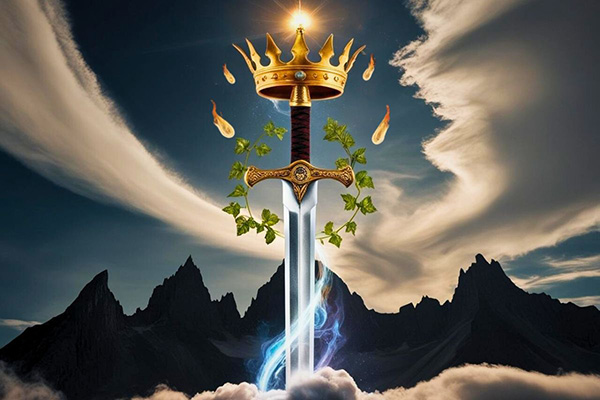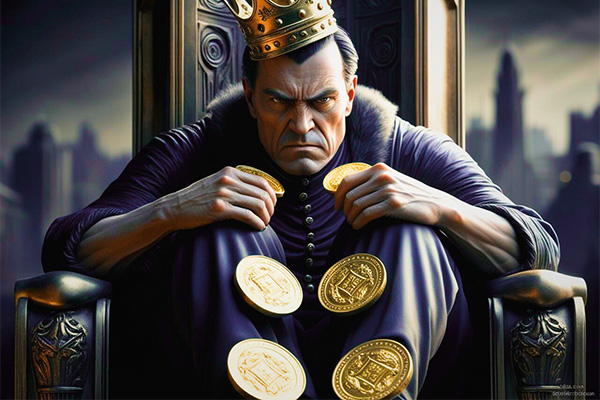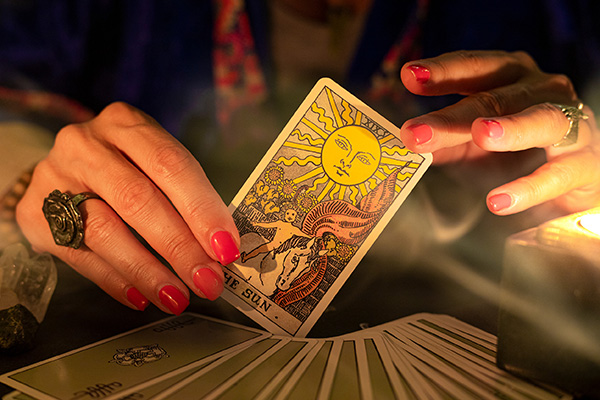tarot cards
Tarot Forecast April 2025: Five Of Wands
 The Five of Wands sets a confrontational tone this month, predicting energies of challenge, competition, and inner or outer conflict.
The Five of Wands sets a confrontational tone this month, predicting energies of challenge, competition, and inner or outer conflict.
But don’t be alarmed by the mayhem and drama it implies — this is not a card of disaster. Rather, it’s a reminder that the most meaningful growth often comes from pushing through obstacles, navigating differences, and finding our unique voice amidst the chaos and discord.
The Five of Wands represents differences that are not insurmountable, but rather opportunities for growth through constructive conflict. You may find yourself in situations where differing opinions, clashing ideas, or rivalries take center stage.
While these moments may feel chaotic at first, they have the potential to lead to breakthroughs and innovative solutions. Embrace the chaos as an opportunity to sharpen your skills and prove your resilience.
In the coming weeks you may experience moments of intensity, whether in your relationships, your career or your personal life. But this energy also urges you to rise above, to think creatively, and to remain adaptable.
While this card does not promise smooth sailing, its message is one of growth through resilience. By maintaining balance, addressing conflict head-on, and remaining open to collaboration, you can turn this month’s challenges into stepping stones to success. It’s a time to fully engage, adapt, and emerge stronger on the other side.
Unlock The Door To Mental Freedom
 We’ve all been there — lost in thought, replaying a conversation from years ago, wishing we’d said something different, or fixating on something that hasn’t happened yet and probably never will.
We’ve all been there — lost in thought, replaying a conversation from years ago, wishing we’d said something different, or fixating on something that hasn’t happened yet and probably never will.
Our minds have a clever way of trapping us in the past, or pulling us too far into the future. In the process, we miss the beauty and joy of the present moment.
Being fully present is the key to happiness — the hidden treasure of everyday joy and fulfillment.
When we embrace the here and now, we experience true mental freedom. Instead of being burdened by past regrets or future fears, we begin to see life as it is — vibrant, alive, sometimes challenging, but always full of infinite possibilities and countless blessings waiting to be appreciated!
Think about the last time you were fully immersed in any experience. Maybe it was watching a sunset where the sky lit up with color, listening to music that made your soul soar, or laughing with a friend until your stomach hurt. In those moments, you weren’t dwelling on past mistakes or worrying about tomorrow’s to-do list — you were just there, experiencing life in real time.
Now, think about how often you are distracted by the constant pull of digital technology that keeps you from being fully present. Your phone pinging with notifications, drawing your attention away from the people and experiences around you.
Tarot Forecast March 2025: Ace Of Swords
 This month the Ace of Swords heralds a time of clarity, breakthroughs, and decisive action.
This month the Ace of Swords heralds a time of clarity, breakthroughs, and decisive action.
Representing the power of the mind, truth, and the ability to cut through confusion, the Ace of Swords signals a month filled with sharp insights, important conversations, and fresh perspectives.
Expect newfound mental strength, intellectual growth, and the courage to face reality — bringing clarity to various areas of life in the coming weeks.
Visually, the Ace of Swords presents a striking image. At its center, an upright sword with a gleaming blade symbolizes intellect, reason, and the ability to pierce through uncertainty. A golden crown encircles the blade, adorned with a vine or wreath, signifying success, authority, and the rewards that come from truth and justice.
The sword emerges from a cloud, representing divine inspiration or sudden insight that dispels confusion. Surrounding it, small flame-like orbs known as yods embody divine energy, enlightenment, and guidance from a higher power.
In the background, jagged mountains reflect the challenges one may face — reminding us that while clarity is powerful, the journey to truth is often met with challenges and obstacles.
The Ace of Swords signals a fresh start in thought, ideas, and perception, urging us to embrace truth, reason, and the transformative power of the mind. In the coming weeks, embrace truth in all areas of life — honesty will set you free. Use both logic and intuition, allowing your mind to guide you while staying connected to your heart. Cut through distractions and focus on what truly matters, eliminating unnecessary mental clutter.
Tarot Forecast February 2025: Four Of Pentacles
 This month’s card is the Four of Pentacles, symbolizing stability, control, and a strong desire to protect one’s resources.
This month’s card is the Four of Pentacles, symbolizing stability, control, and a strong desire to protect one’s resources.
It speaks to themes of holding on to what you have earned, both materially and emotionally. However, this card also warns against becoming too protective or possessive, which can lead to stagnation and missed opportunities.
The overarching theme for the month is staying in the flow. The Four of Pentacles reminds us that while creating security and stability is important, true balance and a blessed life comes from allowing life’s energies to flow naturally.
Holding on too tightly in an attempt to control everything blocks new possibilities and opportunities, while carelessly letting go completely can lead to instability and chaos.
The challenge for February is to maintain a foundation that is both secure and adaptable — holding on to just enough to guide your path, but remaining open to the unfolding currents of life.
Traditionally, the Four of Pentacles depicts a man sitting firmly on a throne holding four pentacles or coins. He’s holding them firmly, with one balanced on his head, one in his arms, and two under his feet. This image symbolizes material attachment, greed, stinginess, and fear of loss. He is so focused on clinging to his precious possessions that he can’t concentrate on anything else.
The Multi-Layered Magic Of The Tarot
 It’s no secret that the Tarot is my favorite divination tool. It is like a trusted assistant to me, always there to provide support and clarity, both in my professional work and in my own spiritual practice.
It’s no secret that the Tarot is my favorite divination tool. It is like a trusted assistant to me, always there to provide support and clarity, both in my professional work and in my own spiritual practice.
Do you know how sometimes you have a gut feeling about something, but you can’t quite put it your finger on it? Or how sometimes you have trouble remembering someone’s name, even though it’s on the tip of your tongue?
Well, that’s how the Tarot helps me when I read for people. It often helps me bridge everyday life with the esoteric and translate psychic messages in a more practical way.
The cards act as a metaphysical magnifying glass, sharpening my psychic impressions and intuitions into clear messages, guidance and predictions. Sometimes it is just a single symbolic element in a card that jumps out, demanding attention and holding the key to unlocking the essence of the message.
A single Tarot card can reveal a plethora of meanings and insights, each layer shaped by that particular reading. Tarot is deeply symbolic and fluid, allowing each card to be interpreted in myriad ways.
First, the context of the reading is important. Whether the question is about love, career, health, finances, or personal fulfillment, the meaning of a card can change significantly. For example, the Two of Cups could mean a romantic partnership in a relationship reading, but a harmonious business partnership in a career reading.
Second, the client’s state of mind and personal circumstances influence the interpretation of the card. Their experiences, desires, and fears color how the imagery and symbolism will be perceived by the psychic. The same Two of Cups might highlight existing trust issues for one person, while signifying a newfound connection for another.
Tarot Forecast January 2025: Two Of Swords
 This month the energy of the Two of Swords takes center stage. It is a card of indecision, stalemate, reflection, and difficult choices, potentially predicting that we may face uncertainty, difficult decisions and the need for introspection as we move into the New Year.
This month the energy of the Two of Swords takes center stage. It is a card of indecision, stalemate, reflection, and difficult choices, potentially predicting that we may face uncertainty, difficult decisions and the need for introspection as we move into the New Year.
The Two of Swords represents moments in life when we find ourselves at a crossroads, weighing options and feeling the need to pause before making an important decision. It often comes up in readings when there is a stalemate or dead-end situation where no progress can be made until a decision is made or some action is taken.
The Two of Swords depicts a blindfolded figure sitting by a still body of water holding two crossed swords. The blindfold symbolizes the inability or unwillingness to see the whole picture or face a choice. The crossed swords signify inner conflict or conflicting choices, while the water in the background suggests the emotional undercurrents influencing the situation.
Traditionally, the Moon also appears in the card, representing uncertainty, mystery, and the unknown. Together, these symbols paint a picture of introspection, duality, and the need to find clarity and balance.
The card signifies the need to balance opposing forces or ideas. It emphasizes the importance of finding balance in a challenging situation. It can also represent emotional turmoil or an inability to reconcile conflicting aspects of a situation.
The Two of Swords encourages us to seek clarity, face challenges head-on, and strive for balance in our choices and decisions. It reminds us that avoiding a problem won’t make it go away; instead, it’s important to face it with a clear mind and an open heart.
